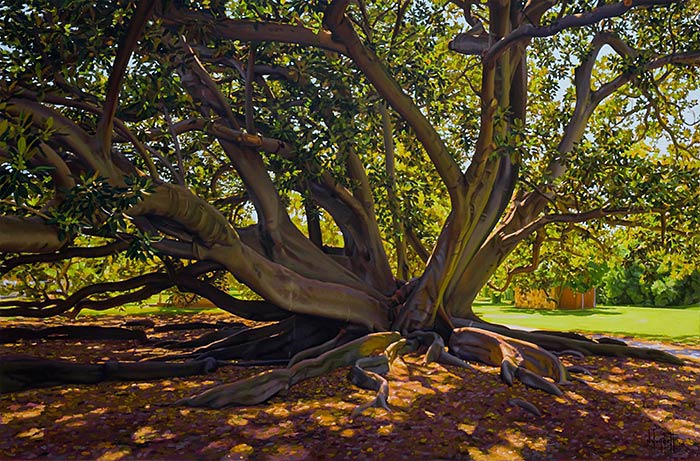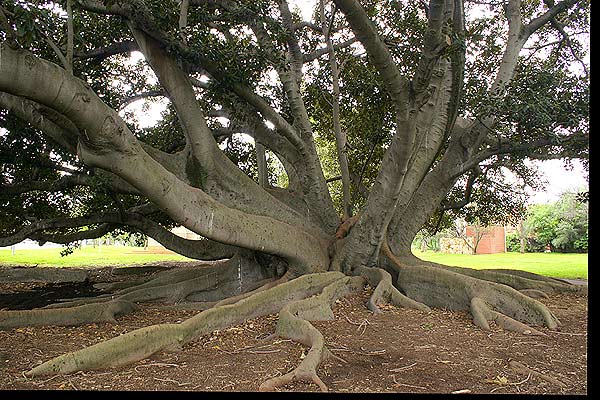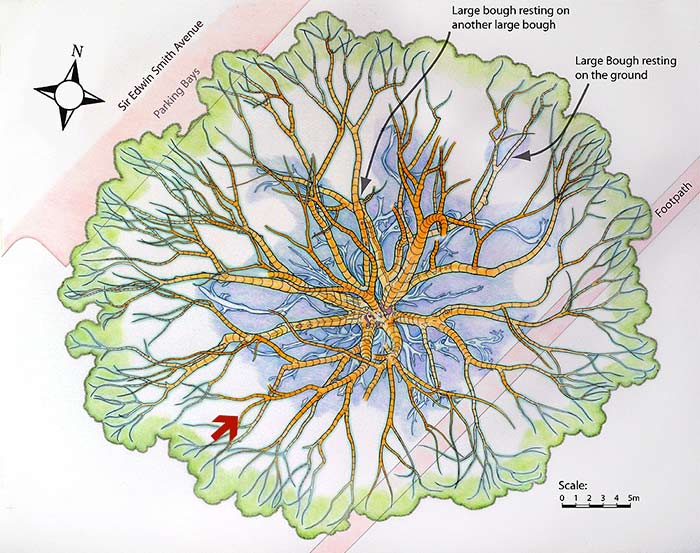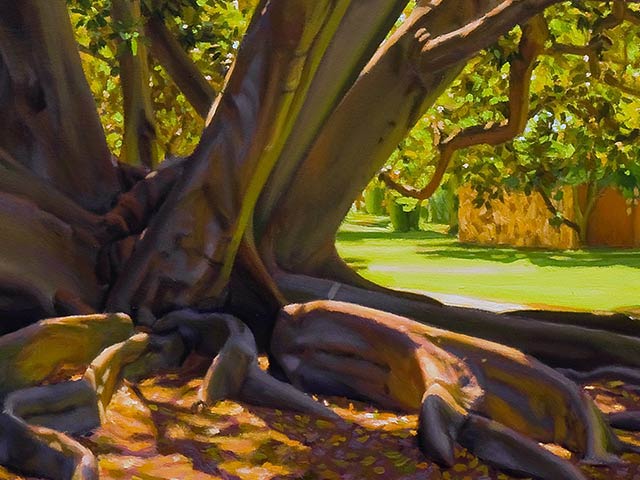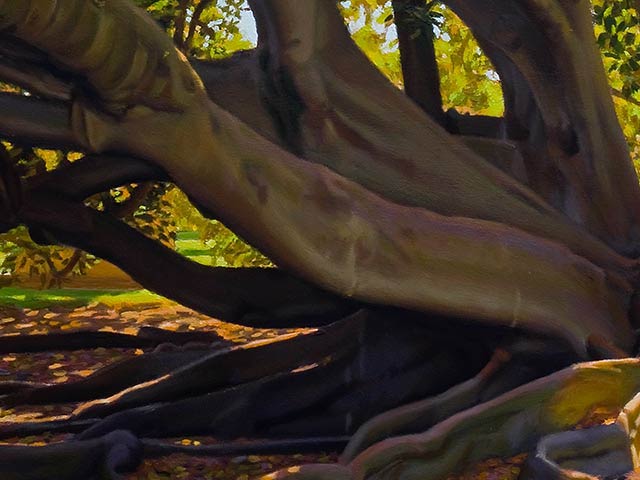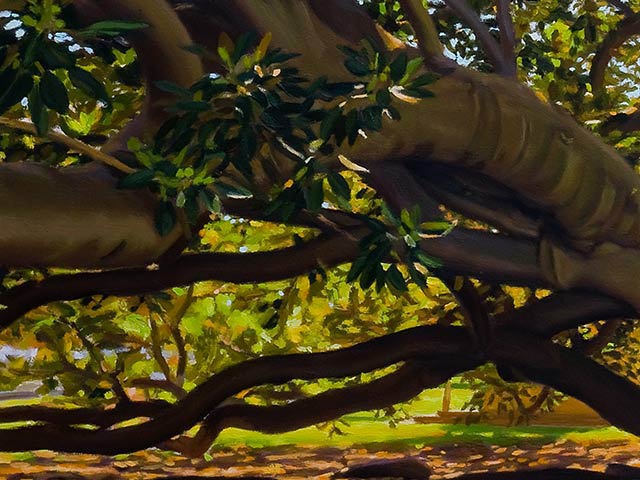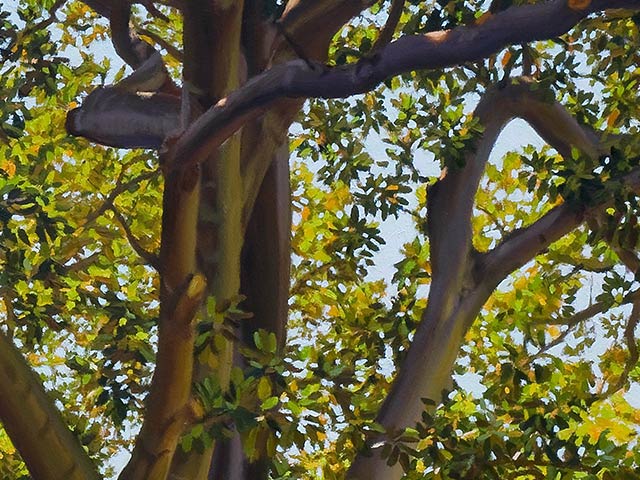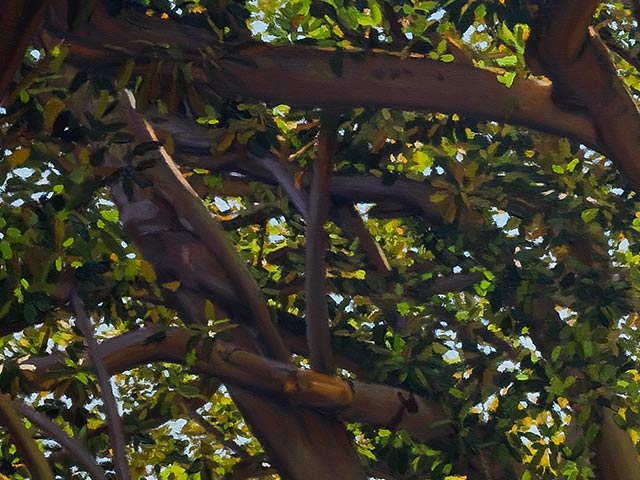90 cm (w) x 60 cm (h), oil paints on board.
Date produced: March 2017 - September 2018
The tree’s scientific name: Ficus Macrophylla Common name: Moreton Bay Fig Tree (an Australian native tree, but not native to this region) Location: The tree is located in the maintained Park Lands that surround the city of Adelaide in South Australia. It is in the Park Lands directly between the city of Adelaide and North Adelaide, in a section called "Angas Gardens". It grows near the south-eastern corner of Sir Edwin Smith Avenue and War Memorial Drive. If you are walking from the City of Adelaide along King William Road, after you cross the Adelaide Bridge, take a pathway to the right and you should see the large tree on the other side of War Memorial Drive. We live in an amazing world. I find a lot of beauty and interest, and gain immense inspiration from the natural world around me.
This painting tries to capture a single view from the real world, just enjoying the colours, tones, forms, spaces, sounds, smells and general magic from being under the sunlit canopy of this magnificent Moreton Bay Fig tree, growing in a highly accessible place in the Adelaide Park Lands. It felt special just to be close to such a huge living organism, with its own atmosphere and amazing spreads of massive boughs and exposed buttress roots.
Trees are major natural elements growing amongst most human living environments (largely by human choice). They are homes, hunting grounds or temporary resting places for diverse populations of birds, small mammals, and insects ‘living in the wild’, and so provide opportunities for society-based people to ‘tap into’ the vitality of bolder, wilder living. Trees also provide shade, oxygen, soothing white noise, charming bird calls, changing spectacles of light, colour and organic space, lovely ‘figurative’ organic forms, and often a ‘spiritual-like’ and peaceful sense of connection with the natural world. The appreciation of trees and the natural environments they provide are cross-cultural experiences, open to nearly all people. As ‘models’ for drawing and/or painting, trees naturally hold their ‘figurative poses’ for long spans of time and their ‘static nature’ easily allows for study through a range of seasons, times of the day, or various weather conditions. This tree is a natural magnet for most people who walk past it, and there are many people who walk past it every day: many university students walking between residencies in North Adelaide and Adelaide University, city workers who live in North Adelaide, people who walk to work in the Melbourne Street area, and workers at the Women and Children’s Hospital nearby. Many of these local people have expressed the view that this tree is ‘the best tree in Adelaide’. Certainly, many people can feel something special about this tree. While working at the tree, I have met and seen many tourists from all over the world stop at the tree and take photographs of it. Common reactions to the tree are for people to want to climb in it, and to be photographed next to it. It is certainly a mighty organism, looking very healthy and strong, and growing in a prominent spot.
I first encountered this tree about 40 years ago in 1983, soon after moving to Adelaide, and I spent considerable time then doing some serious drawings of it. At that time it would have been about 105 -110 years old. After the span of another 40 years since 1983, there seemed to have been very little change in the character of the forms of the tree. The tree seems to be going through a very stable time in its life. I realised when I first came across the tree in 1983 that it was an excellent place to be at, but now I am seeing just how special that one tree is. It is a huge tree, with branching very close to the ground. Most people can easily get amongst its massive boughs and the spaces between them. That is something very unusual in itself. But the tree also has a vast network of twisting buttress roots sitting up from the ground that makes it feel like an inviting playground. Being close to the tree means being in a changed environment; heavily darkened by the thick canopy of rubbery leaves, surrounded by many active birds with tropical calls in the canopy, amongst pleasant earthy smells of rotting figs and decaying leaves, and an atmosphere where my senses seem to be heightened (there are masses of interesting details everywhere I look). It feels special to have free access to the Adelaide Park Lands. They are an amazing resource, surrounding the City of Adelaide. I am glad and feel proud that the City of Adelaide values and protects this precious and unique resource.
|
